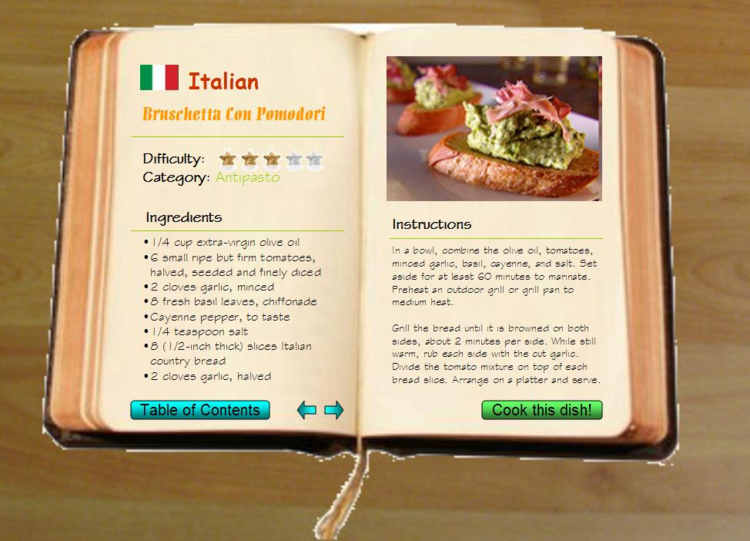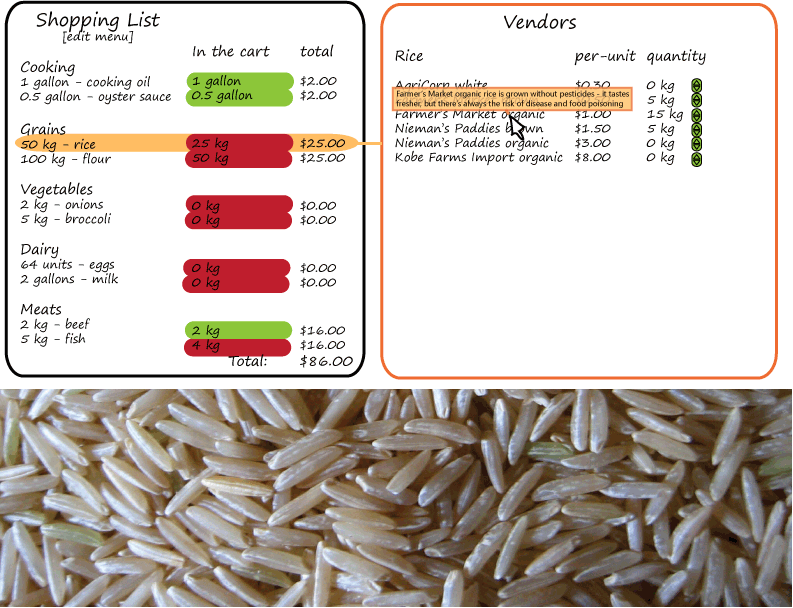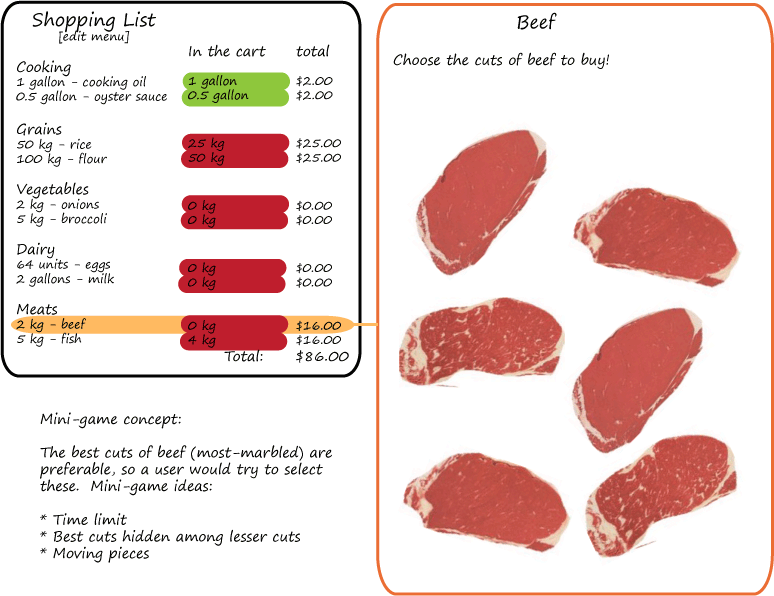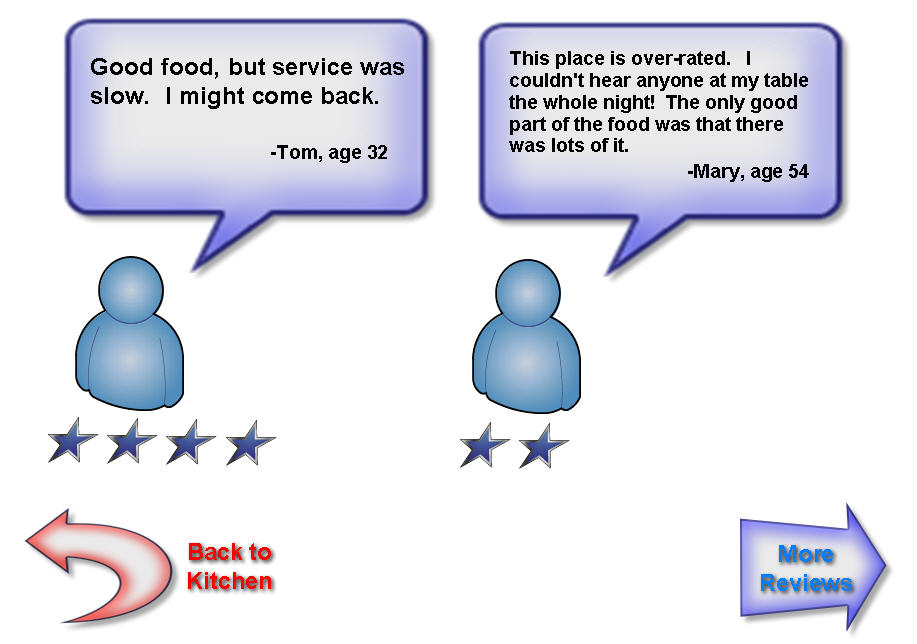Group Brainstorm-Group:Ate
From CS 160 Fall 2008
Group Ate's Group Brainstorm assignment.
Contents |
Group Members
Brainstorm
- Foreign cultures
- Travel simulation
- Attractions
- Rituals / Traditions
- Language
- “Friend” as guide in country
- Multiplayer “foreign exchange”
- Photos
- Framing / Quality
- Photos scavenger hunt for points
- Context: play on the train (individually)
- Cell phone game – at the bar
- Cell phone game – in a home/party environment
- Breaking the ice
- Asking for help
- “Couch-surfing”
- Food and drink as souvenirs
- Recipes
- Multiplayer recipes database
- Picture of the dish -> get recipe
- Mini games: separate and somewhat random
- Etiquette – simulation game: get rated on scale of gentleman <-> snob
- Fancy restaurants
- Different countries
- Take pictures of food
- Goal: become a food critic
- Identify the dish
- Progression: fast food -> fancy
- as Restaurateur / Business owner
- go to grocery store
- cook/caterer in food competitions
- Includes table service
- Food critic mini-games – e.g. lazy susan usage
- a la “Wario Ware” on Wii
- cooking
- Picking dishes
- Iron chef
- Competitive eating
- build “endurance”
- game play: keeping meter in certain range
- Etiquette: setting the table
- Different venues/countries as caterer (as bonus game)
- specialty dishes
- “SimRestaurant”
- Finances on/off to change game complexity
- Fast food restaurant as tutorial
- Game consists of a “campaign” with following four elements
- Setting a menu (using a recipe book)
- Picking ingredients and grocery shopping (e.g. farmer’s market vs. store)
- cooking
- serving (with etiquette aspects)
- Learn by visiting other restaurants
- Progression from short order-cook -> celebrity/iron chef
- Zagat/Michelin ratings
- “Yelp”-like feedback
- “level-up” via competitions
- level determines how fancy of a restaurant you can cook at
- Win money in order to open (more) restaurants
Idea Selection
We began considering foreign cultures and most people's unfamiliarity with them. We quickly honed onto food and culinary culture as one particular area where visitors to foreign countries were most unfamiliar and often encountered the greatest culture shocks.
We began formulating our idea for a serious game to address the solution after that. Our initial ideas started with a series of mini-games teaching etiquette, but we ran into feasibility problems after delving deeper into how to translate mini-games based on restaurant etiquette into a cohesive game. We branched out from the idea that the user actually needed to be placed into the role of a traveler to be educated about foreign cultures, and started with the idea that placing the user into various roles centered around culinary culture (restaurant manager, cook, waiter/server, diner) would serve to offer both a more immersive and comprehensive experience that could completely cover a foreign culinary experience, and also have the potential for a more cohesive and engaging gaming experience.
Project Description
Target Users
Casual users who are interested in learning about foreign foods and culinary cultures. Examples of more specific subgroups in this group might be vacation or business travelers who are interested in learning about countries they are about to visit, especially things like foreign dishes or restaurant etiquette.
Problem Description
Many individuals are ignorant of foreign culinary cultures, especially eating etiquette and the types of dishes or food served.
Problem Context
Growing up, many people's exposure to food is confined to what they experience eating at home or within their local community. As a result, many people are unfamiliar with foreign food culture and etiquette. First-time travelers, for example, often encounter a culture shock when dining in a foreign country, where the types of food available, the way they are cooked, or the dining atmosphere at restaurants seem completely alien to what they are used to.
Why Serious Games are a Good Technology for the Problem
While traveler's guides have been around for ages in the forms of text, audio, images, and video across mediums like books, audiotapes, websites, and tv shows, the distinct disadvantage of these guides is that they inherently attempt to pass on knowledge in a one-way interaction. While one can always read about restaurant etiquette, see pictures of foreign dishes, or even watch a television show on foreign cooking, none of these can provide the same kind of "hands-on" experience and memorization that a real-life scenario, such as preparing an actual Italian dish or taking up a catering job serving Chinese food might.
Of course, such a "real-life" experience is not very practical - one can always look up recipes and attempt to cook them, but this requires a user to be able to actually cook food (something an adult might be able to handle, but not a young child), and also own the proper cooking equipment (a college student with a microwave and a meal plan wouldn't have the tools to learn about baking soufflés or grilling a steak). In addition, other aspects, such as dining etiquette or restaurant atmosphere, are not readily accessible by any casual user (at best they might find a local foreign-food restaurant that may provide a semi-authentic experience).
Serious games provide a solution by offering some level of interactivity - while a game obviously can not replicate a real-life experience exactly, it involves and requires user interaction in a way that books, pictures, and videos cannot. For instance, in learning about food etiquette, participating in a utensil-placing mini-game imparts the muscle memory of physically placing the utensils in the correct locations. Similarly, a game can provide a simulation of foreign behavior with real-time responses to the user's actions. In this way, serious games immerse users in an environment that promotes the retention of the information provided.
Solution Sketch
Our main idea for the serious game is to implement a simulation of the running of a restaurant from more of a culinary, rather than financial, standpoint. Thus the game might include mini-games centering on different aspects and steps of culinary preparation in different cultures and situations.
Recipe book
Like real restaurant owners, players might have the flexibility of creating menus for their restaurants. Rather than allowing players to select the menu items from an inexhaustible list of recipes, players would choose their dishes from their own recipe (cook) books. The recipe books are something the players would maintain throughout the game and would serve as a reference guide for players when they shop for ingredients and prepare food.
As players progress through the game, they can acquire new dishes to add to their recipe books. Dishes can be categorized by (1) the countries or regions from which they come from, (2) their type (i.e. antipasto, main course, and dessert), and (3) cooking difficulty to name a few. Players would then have to choose dishes that are within their skill level to make and moreover, match the themes of their restaurants. Additionally, the diversity of food offered in a restaurant can be used as a rating factor.
Shopping ingredients
Two concepts for shopping for ingredients: one is a simple shopping system, where you can buy different brands that would have different benefits/costs.
Another is a mini-game concept - if you do well you end up with better ingredients, which combines with the cooking stage to give you a better final food score (or customer reviews).
Cooking
This would be the stage at which point you must actually use the foods you have purchased to make the correct dishes as per the recipe book, with fun ways of integrating challenges of cooking into making the recipe memorable to the player. A failure in these challenges can lead to bad ratings on the customer feedback section.
This stage of the game should likely be kept pretty simple, but include many different elements of the venue you are working in - for instance, in a stage in a club, you might be instead serving drinks instead of food. This might also include a minigame centered around handling the music in the club while serving drinks, but these outside tasks should be kept at a minimum and only be used as "side challenges" to make the main challenge more difficult, so as not to distract from the main point of the game, which is culture through food, not music - that would require a whole other game.
Serving, table setting
A big part of the game is about experiencing and remembering how to deal with various worldwide versions of table manners, so that you can reproduce the correct table manners at your own restaurant. For example, in some cultures it is okay to have your elbows on the table or it's okay to not have them on; in some cultures it is considered really bad manners; and in some cultures it is required because otherwise people will suspect that you might be feeling up your tablemate. Then take French/Western European table manners for example. Which fork do you use for the salad - inner, or outer? How do you break up the bread, with your hands or your butter knife? What do you do when the sommelier comes with a bottle of wine? (You taste it.) How do you taste the wine? Do you aerate it, then smell it, or smell it then aerate it? What is the proper way to actually taste it?
We can teach these things with a motion-sensitive input device such as the Wii Remote. Then we can ask the user to pretend it is a wine glass, and go through the motions of tasting a wine. These are all very distinct motions that can be picked up even though the Wii Remote's motion sensitivity is actually not that precise.
Similarly, we could simulate the idea of having a place setting with multiple utensils with wii remotes. Then, you get a salad, and you have to pick up the right wii remote and poke it into the salad to register your decision. While this particular example isn't very practical, all these things help with inspiring muscle memory.
I'm not sure we can necessarily make all of these learning tasks engaging/amusing, but at least we can make them as interactive as possible to involve the user.
Customer feedback
One means for explicit feedback to the player is the "Customer Feedback" mechanism. These "reviews" will give both quantitative and qualitative feedback on how the player is performing. If the player could be doing something better, this is natural way to point that out. Ideally, this interface will be a balance of enough information and details for the player to improve specific gameplay areas, as well as general enough and easy enough to ready quickly that the player does not have to try too hard to decipher or study the reviews to get feedback.







